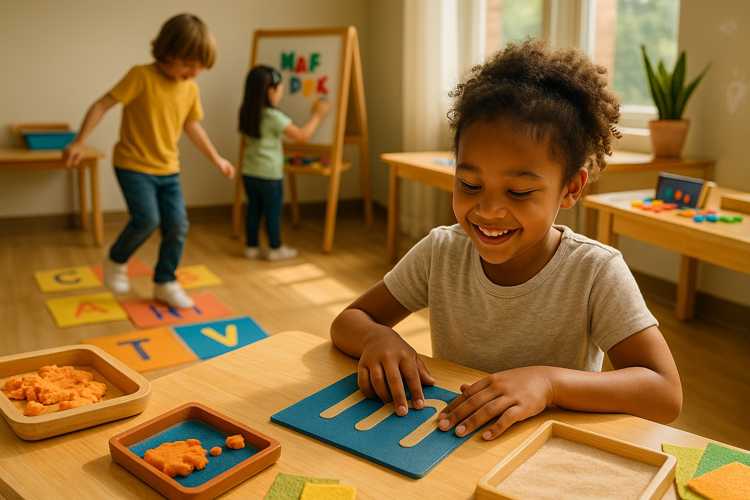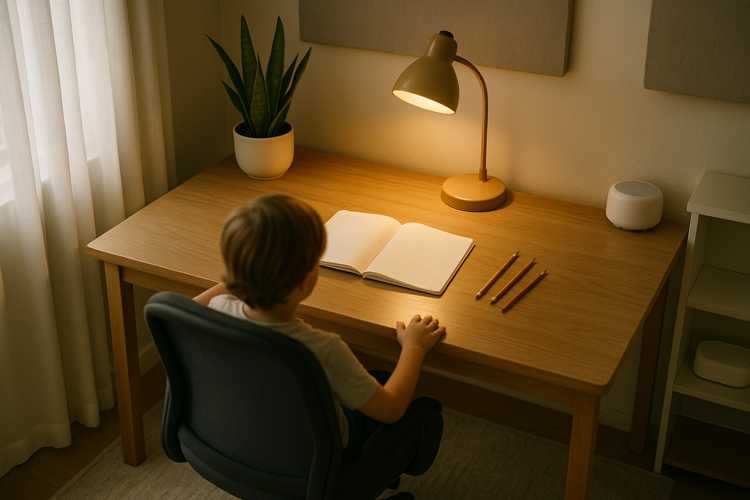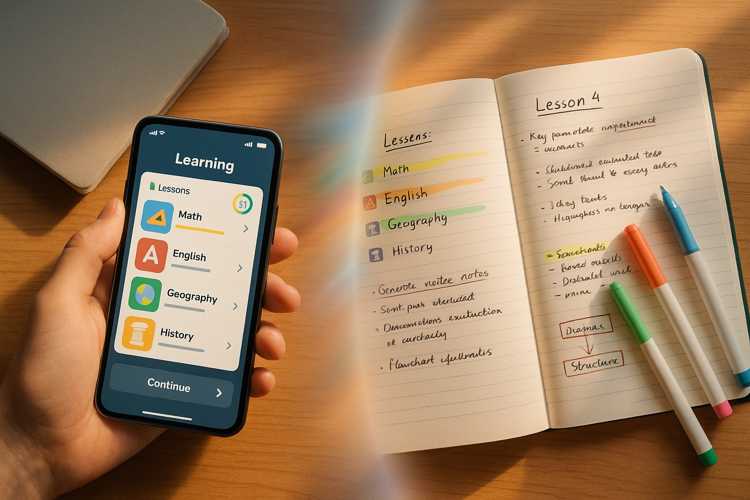From Frustration to Fun - Turning Writing Practice Into Play

Image made with AI (DALL-E)
Discover game-based writing exercises that transform reluctant writers into eager learners while strengthening fine motor skills through play-based activities that actually work.
Picture this: It's homework time, you pull out the handwriting workbook, and your child suddenly develops a mysterious case of "my hand is too tired" syndrome. Sound familiar?
Here's the plot twist—your kid isn't being difficult. They're just human. The traditional "write these letters fifty times" approach is about as exciting as watching paint dry while doing taxes. No wonder they're running for the hills.
But what if I told you there's a secret weapon that makes writing practice feel less like dental surgery and more like recess? Enter game-based writing exercises—the sneaky parent hack that turns fine motor skill development into actual fun. We're talking about activities where kids beg for "just one more round" instead of negotiating their way out of practice. Let's dive into how to make this magic happen in your home.
Why Traditional Writing Practice Fails (And Why Games Win)
The Psychology Behind Writing Resistance
Traditional writing drills fail for a simple reason: they feel like work. And not the good kind of work—the mind-numbing, soul-crushing kind that makes you question your life choices.
When we frame writing as an obligation, a child's brain goes into threat mode. Suddenly, every imperfect letter becomes evidence of failure. That's a lot of pressure for someone whose hands are still learning basic coordination.
Game-based writing exercises flip this script entirely. Instead of "you must practice," it becomes "let's play." That subtle shift activates completely different neural pathways—the ones associated with curiosity, exploration, and joy. Research shows kids stay engaged 40% longer with play-based activities than traditional reward systems.
How Games Strengthen Fine Motor Skills Naturally
Here's where it gets interesting: repetition is still happening in games, but your child doesn't notice because they're having too much fun.
When kids trace letter mazes or race against timers, they're doing the same hand movements as traditional practice. But the game context removes the anxiety. Their grip relaxes, their movements become more fluid, and muscle memory develops naturally.
Think of it like learning to ride a bike. You could lecture about balance and physics, or you could just let them ride with training wheels until it clicks. Games are the training wheels for writing.
The Play Advantage: Occupational therapists consistently recommend game-based activities because kids improve pencil grip and hand strength through enjoyment rather than correction—which means less "hold it like this" nagging from parents.
Game-Based Writing Exercises That Actually Work
Letter Maze Adventures
Transform basic letter tracing into a quest. Draw winding paths that form letters, add obstacles like "lava zones" (red areas) they can't cross, or create stories where their pencil is a superhero navigating through the letter landscape.
The beauty? They're practicing letter formation while genuinely engaged in the narrative. My favorite version involves tiny plastic figurines that "walk" along the letters as kids trace them. Suddenly, it's not handwriting practice—it's an action movie.
Pro tip: Start with large mazes on poster board before shrinking to notebook size. Building confidence matters more than immediate perfection.
Story Dice Writing Games
Grab some dice (or make your own with images), roll them, and have your child write a single sentence about what appears. That's it. One sentence.
This approach tackles two monsters at once: it reduces perfectionism anxiety (it's just one sentence, who cares if it's messy?) and boosts creativity. The randomness removes the "I don't know what to write" excuse, and the short format prevents overwhelm.
As confidence builds, expand to three-sentence stories. Before you know it, they're writing paragraphs without realizing they're doing "work."
Alphabet Racing Challenges
Set a timer for 30 seconds and see how many legible A's they can write. Next round? B's. Make it competitive (against their own record, not others) and track improvements on a visible chart.
The competitive element transforms boring repetition into an engaging challenge. Kids who normally resist writing suddenly want to beat yesterday's score. That's the power of gamification.
Warning: Balance speed with quality. If letters become illegible scribbles, slow it down. The goal is building good habits, not reinforcing bad ones.
Invisible Letter Detective
One person "writes" a letter in the air (or on their back) while the other guesses and then writes it on paper. This multisensory approach reinforces letter recognition while adding a mystery element.
This game works brilliantly for kinesthetic learners who struggle with traditional visual methods. Plus, it requires zero supplies—perfect for waiting rooms, car rides, or anywhere boredom strikes.
How To Implement Game-Based Writing Practice (The Step-by-Step)
Step 1: Identify Your Child's Resistance Points
Before diving in, play detective. Does your child struggle with: - Grip strength (cramping after a few minutes)? - Letter formation (confusion about where to start)? - Motivation (they'd rather do literally anything else)? - Perfectionism (meltdowns over "messy" letters)?
Knowing the specific challenge helps you select the right game format. No point racing against a timer if grip strength is the issue—that'll just create more frustration.
Step 2: Start With One Game Format
Resist the urge to try everything at once. Pick one game that addresses your child's main challenge and stick with it for a week.
Consistency beats variety in the early stages. Let them master one format before introducing complexity. This builds confidence and prevents the "too many rules" overwhelm that defeats the play-based purpose.
Step 3: Keep Sessions Short and Sweet
Three to five minutes. That's it. Seriously.
The secret to building a sustainable habit isn't marathon sessions—it's showing up daily without dread. A short, fun game every day beats a 30-minute battle three times a week. Plus, stopping while they're still having fun leaves them wanting more.
Step 4: Make Progress Visible
Create a simple chart where they can see improvements. Stickers, checkmarks, drawings—whatever resonates with your child.
Visual feedback satisfies that basic human need to see growth. It transforms abstract skill development into concrete evidence: "Look, last week you wrote 12 A's in 30 seconds, now you're at 18!" That's powerful motivation.
Parent Hack: Take photos of their writing weekly. The progress over a month is usually dramatic enough to impress even the most skeptical kid.
Common Pitfalls to Avoid
Making Games Too Complicated
I've seen parents create elaborate game systems with multiple rule sets, point calculations, and reward tiers that would confuse a game show host. Don't be that parent.
If you need a manual to explain the game, it's too complex. Simplicity wins. The game should enhance writing practice, not overshadow it with cognitive overhead.
Prioritizing Speed Over Quality
Yes, timed challenges are fun. But if your child starts developing a death grip on their pencil or writing illegibly just to beat the clock, pump the brakes.
The goal is building proper technique through repetition, not reinforcing bad habits quickly. Slow and correct beats fast and sloppy every single time.
Forgetting to Celebrate Small Wins
In our achievement-obsessed culture, we sometimes forget that mastering a single letter is genuinely impressive for a small human still developing motor control.
Celebrate the little victories. A straighter line. A more consistent letter size. Better spacing. These incremental improvements matter more than the final product.
Frequently Asked Questions
At what age should I start game-based writing practice with my child?
The sweet spot is typically ages 4-7, when kids are developing pre-writing and early writing skills. Younger children (3-4) benefit more from hand-strengthening activities like playdough and painting before formal letter practice. Older children (7+) can handle more complex narrative games and competitive formats. That said, if your 8-year-old still resists writing, it's never too late to make it playful. Better late than never applies here.
How do I know if the games are actually improving fine motor skills?
Track these four indicators over 4-week intervals: pencil grip quality (are they holding it correctly without constant reminders?), letter consistency (do repeated letters look similar?), hand fatigue duration (can they write longer without cramping?), and overall speed improvements. Take baseline photos or samples, then compare monthly. The changes are usually obvious—and motivating for both of you.
Can game-based activities replace formal handwriting instruction entirely?
Nope, and they shouldn't. Think of games as the motivation fuel that makes formal instruction stick. Your child still needs proper technique instruction, letter formation guidance, and structured practice. But games bridge the gap between "I have to do this" and "I want to do this." They complement formal lessons by building the muscle memory and confidence that makes the technical instruction actually land. It's not either-or—it's both working together.
What if my child still resists even game-based practice?
First, check your game selection. Is it truly play-like, or is it thinly disguised busywork? Kids have incredible BS detectors. Second, shorten the sessions even more—start with just one minute if needed. Finally, consider whether underlying issues like dysgraphia or sensory sensitivities might need professional evaluation. Persistent resistance sometimes signals more than motivation—it might be telling you something needs additional support.
Are there specific games that work best for different learning styles?
Absolutely. Kinesthetic learners thrive with invisible letter games and sensory writing (shaving cream, sand trays). Visual learners love letter mazes and watching progress charts grow. Auditory learners benefit from games with chants or songs accompanying letter formation. The best approach? Try different formats and let your child's enthusiasm guide you. They'll naturally gravitate toward games that match how their brain works best.
The Bottom Line: From Resistance to Resilience
Here's what I've learned from countless parents who've made this shift: the transformation isn't always dramatic or instant, but it's real.
Game-based writing exercises work because they address the root cause of writing resistance—the psychological dread that makes every practice session a battle. By reframing writing as play, you're not just building fine motor skills. You're building a positive relationship with written expression that'll serve your child for life.
The most beautiful part? You don't need fancy curricula or expensive programs. You need creativity, consistency, and a willingness to prioritize joy over perfection. When writing practice stops feeling like punishment and starts feeling like playtime, everything changes.
Your mission (should you choose to accept it): Pick one game from this article and try it for just three minutes today. Notice what happens when you remove the pressure and add the play. I'm betting you'll see a different kid show up—one who's curious, engaged, and maybe even smiling while holding a pencil.
Now go forth and gamify. Your future self (and your child's future teacher) will thank you.
Links marked with an asterisk (*) are affiliate links to external offers. If you click on such a link and make a purchase through it, we receive a commission from the provider. The price does not change for you.
Related Articles

Building Reading Confidence Through Multisensory Activities That Actually Work
Discover research-backed hands-on reading techniques using touch, sound, and mov...
10 min read
Creating a Calm Learning Space at Home - A Parent's Guide to Better Focus
Discover how lighting, sound, temperature, and texture impact your child's focus...
13 min read
Bridging Apps and Offline Learning - Making Tech Work for You
Discover how combining educational apps with physical workbooks boosts retention...
8 min read
Why Consistency Beats Complexity in Teaching Basic Skills (Especially for Neurodivergent Learners)
Discover how structured repetition and daily routines help neurodivergent learne...
11 min read
